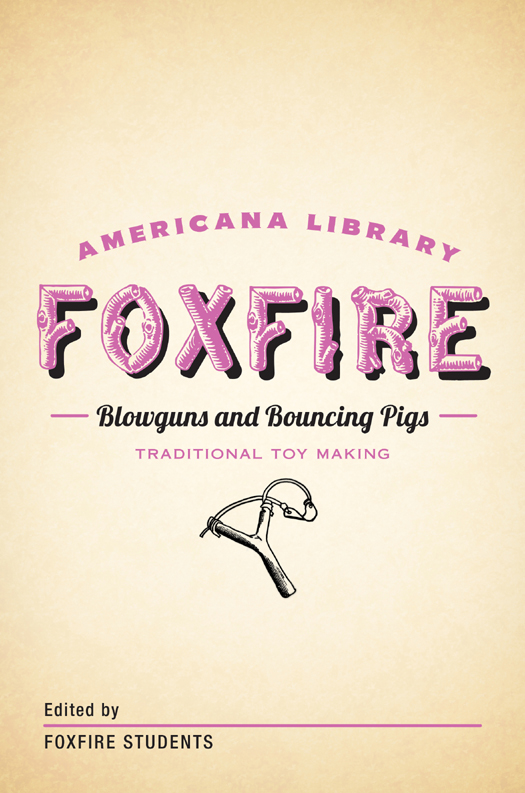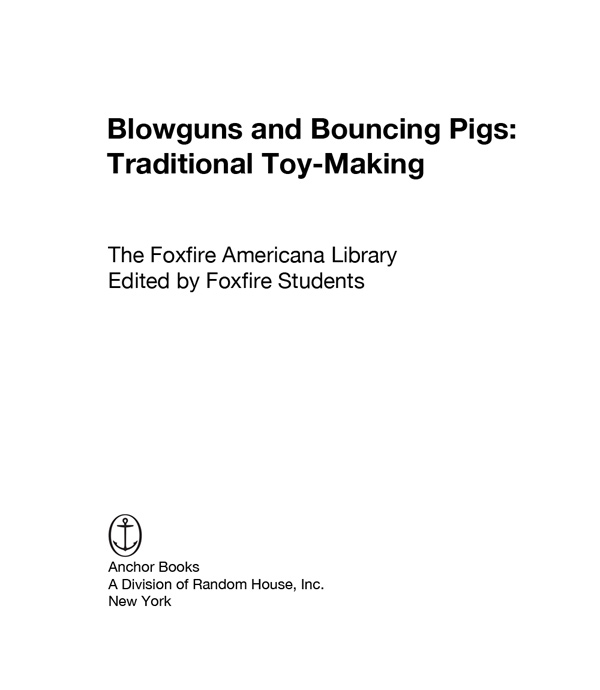ANCHOR BOOKS EDITION, SEPTEMBER 2011
Copyright 1980 by the Foxfire Fund, Inc.
All rights reserved. Published in the United States by Anchor Books, a division of Random House, Inc., New York.
Anchor Books and colophon are registered trademarks of Random House, Inc.
Originally published in Foxfire 6, 1980 by The Foxfire Fund, Inc. Reprinted by permission of Random House, Inc.
eISBN: 978-0-307-94825-0
v3.1
Table of Contents
A NOTE ABOUT THE FOXFIRE AMERICANA LIBRARY SERIES
For almost half a century, high school students in the Foxfire program in Rabun County, Georgia, have collected oral histories of their elders from the southern Appalachian region in an attempt to preserve a part of the rapidly vanishing heritage and dialect. The Foxfire Fund, Inc., has brought that philosophy of simple living to millions of readers, starting with the bestselling success of The Foxfire Book in the early 1970s. Their series of fifteen books and counting has taught creative self-sufficiency and has preserved the stories, crafts, and customs of the unique Appalachian culture for future generations.
Traditionally, books in the Foxfire series have included a little something for everyone in each and every volume. For the first time ever, through the creation of The Foxfire Americana Library, this forty-five-year collection of knowledge has been organized by subject. Whether down-home recipes or simple tips for both your household and garden, each book holds a wealth of tried-and-true information, all passed down by unforgettable people with unforgettable voices.
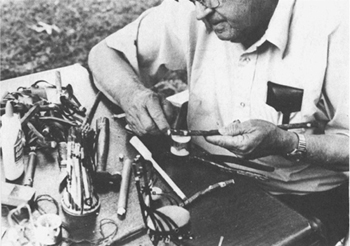
I LLUSTRATION 1 Mr. Davis glues the cup to the stick.
TOYS
Ball and Cup
ARTHUR DAVIS : I havent been making these all my life and I dont know anything about their history. Its a good game, though. If you practice a while, you can get pretty good at it.
The pieces are whittled out of mountain laurel or rhododendron, but you could use other kinds. The handles and the cups are glued together, and I make the balls out of pine wood. But you can use whatever you have. The main idea is to swing the stick with one hand so the ball drops into the cup without touching it with the other hand.
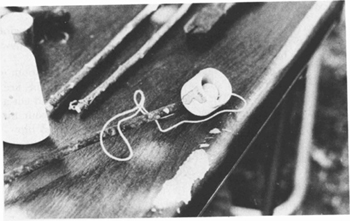
I LLUSTRATION 2 The finished toy.

I LLUSTRATION 3
Blowgun
ERNEST FRANKLIN : Take a hollow weed, or something that doesnt have any sections in it like bamboo, and cut a piece of it anywhere from four to six feet long. That makes your gun.
For the darts, wed take a round piece of hickory about 3/16 inch in diameter and sharpen one end and put it in the fire and temper it a little bit. Then wed take a squirrels tail and cut about a third of it off and fasten that on the other end of your hickory dart. Then you stick that dart in the hollow weed and blow up a storm!
Bouncing Pig
One of the toys Willard Watson makes is called a bouncing pig. A rod runs through the front feet of the pig so that its hindquarters are free to rise up and down. As the crank at the back end of the toy is turned, the mans right arm moves up and down to whip the pig, and each time the pig is whipped, its hindquarters rise off the platform (the mans left leg moves forward, and a rod connected to his left foot and left hand causes his left hand to rise; a rod connecting his left hand and the pigs hindquarters pulls the hindquarters into the air).
Bow and Arrow
LAWTON BROOKS : We made bows and arrows out of hickory wood. Wed take a springy sapling or branch for a bow, shape it right with a knife and put little notches in the ends, and string it with a string. Wed make arrows out of shorter piecesstraight as we could get them. We took umbrella staves one time and made spikes [for the arrows] out of them. Wed tore up somebodys umbrella, got the spikes out of it, and put them in the arrows to kill rabbits, birds, things like that.
LELIA GIBSON : My brother would get a piece of wood, a green saplingit had to be green so it would bend. Hed cut it to the right length, and string a cord on that. Then hed get a straight stick [for the arrow] and hed go to the fields and find stonesold arrowheads the Indians had madeand tie that on the end of the arrow. If they couldnt find arrowheads, theyd use a big twenty-penny nail, but I dont recall now how they fixed that nail on the end of the arrow. They could make the arrows stick into trees.
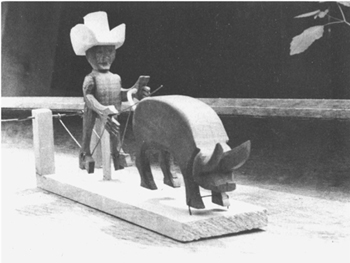
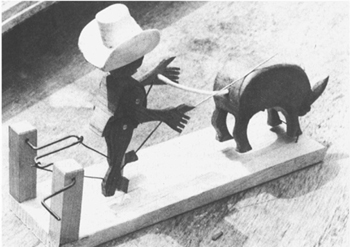
I LLUSTRATION 4 Willard Watsons bouncing pig.
HATTIE KENNY : Arrows were made out of sourwood that grows up in the spring. Let em stand over the winter and cut em to make your arrows.
BUCK CARVER : For the bows wed use hickory or white-oak saplings. Instead of string wed use what they called whang leather, which was strips of ground-hog hide. Then wed wire or tie a nail up in a straight stick for an arrow.
EDD HODGINS : We used string out of cottonseed meal sacks for the string. Thats about all the string we ever got when I was little.
Bubble Blower
LELIA GIBSON : We used to get an old sewing-thread spool, take some soap, and make a lather in water. Wed [dip one end of the spool in the lather] and blow through the other end and make bubbles. Theyd be different colors. Theyd be red, pink, blueall colors.
Bull Grinder
DAVE PICKETT : The Ozark bull grinder was something people say started in the Ozarks. Of course, bull grinders aint the only name it had. Ive heard them called do nothings and smoke grinders. I call them bull grinders because the guy I got the pattern from, thats what he called it. I asked for his permission to use the label off the back of his and I just changed it a little bit. Its a little toy thats good for absolutely nothing except for passifying oneself with something to do other than twiddling his thumbs. I put a label on the back to tell people just what it is: Its for people going either direction, cutting red tape, breaking conversation ice, relieving nervous tension, advanced stages of thumb twiddling, sharpening dull conversations, a reducing gear for big wheels. The worlds most useless necessity is made of selected pieces of well-seasoned out-house wood by retired moonshiners.
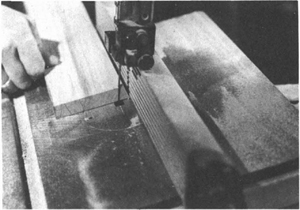
I LLUSTRATION 5 First Dave cuts strips off a poplar board at a 15 angle for the pistons.


